Cold process soap making is dangerous primarily because of lye (sodium hydroxide), which causes severe chemical burns upon skin contact. You're handling a substance that can burn through multiple skin layers within seconds, release harmful fumes, and create unpredictable exothermic reactions. Without proper protective equipment like chemical-resistant gloves and safety goggles, you risk serious injury. Adequate ventilation and precise temperature control are also essential. Learning proper safety protocols can protect you from these significant hazards.
Why Is Cold Process Soap Making Dangerous?
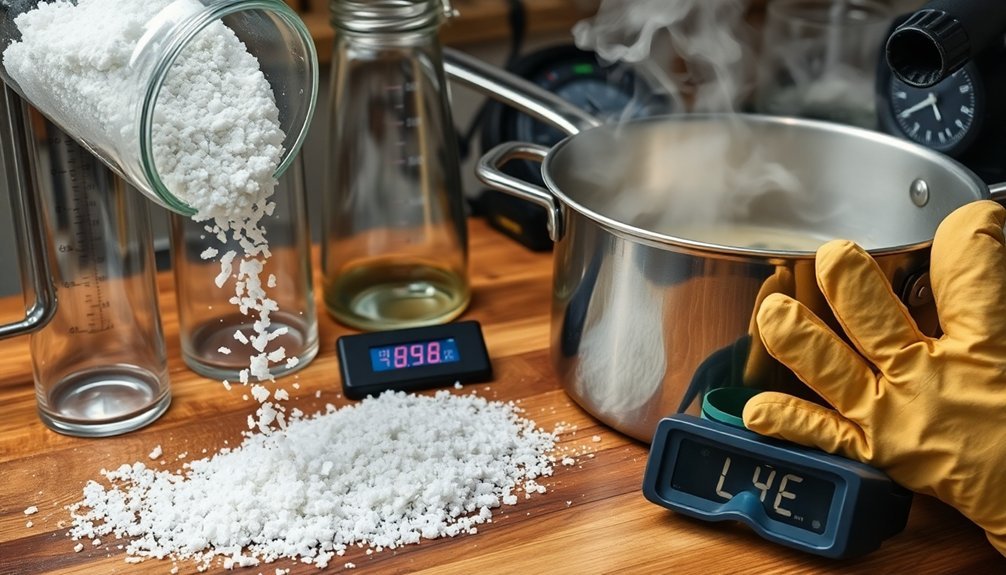
Although creating handmade soap can be rewarding, cold process soap making carries significant risks due to its primary ingredient: sodium hydroxide, commonly known as lye.
This caustic substance can cause severe chemical burns upon contact with your skin during the saponification process. When you mix lye with water, harmful fumes are released that can damage your respiratory system if you're working in poorly ventilated areas.
Improper handling of lye creates dangerous chemical reactions, including unexpected heat and splattering. The high pH environment can cause colorants to morph, affecting your final product's appearance.
To protect yourself, always use personal protective equipment including gloves and goggles. Without these safety measures, you're exposing yourself to potential chemical burns and serious injuries that could have long-lasting effects on your health.
Understanding the Caustic Nature of Lye
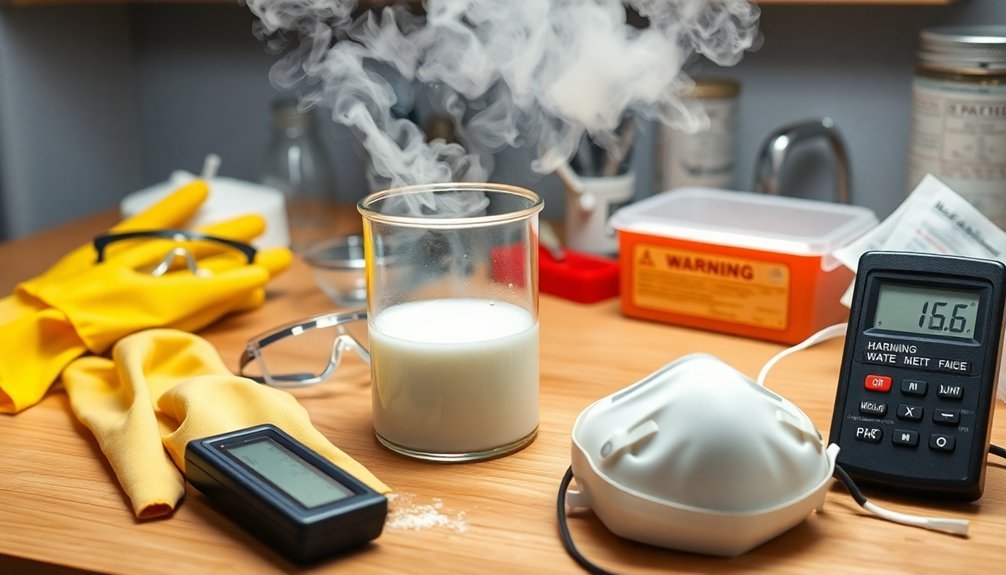
Lye demands your utmost respect as it can inflict severe chemical burns that penetrate multiple skin layers within seconds of contact.
You'll need impermeable gloves, safety goggles, and long sleeves when handling this caustic substance, ensuring no splashes or spills come into contact with your skin.
Working in a well-ventilated area is non-negotiable, as lye releases harmful fumes that can damage your respiratory system if inhaled.
Chemical Burns Risk
Because safety can't be overstated in soap making, you'll need to fully understand the dangerous properties of sodium hydroxide.
Lye can cause severe chemical burns instantly upon contact with your skin or eyes. Even small splashes of this caustic substance produce immediate pain and injury.
Your risk increases during mixing, as lye and water create heat that can cause unexpected splashes. Always wear proper personal protective equipment—gloves and goggles are non-negotiable safety gear.
Work in well-ventilated areas to prevent inhalation of dangerous fumes or dust, which can damage your respiratory system.
Should exposure occur, implement first aid measures immediately: rinse affected areas thoroughly with water for at least 15 minutes and seek medical attention for serious burns.
Never underestimate sodium hydroxide's potential to cause harm.
Proper Handling Required
Beyond understanding the immediate injury risks, mastering proper handling techniques is the foundation of safe soap making. When working with lye (sodium hydroxide), you'll need to approach this caustic substance with respect and caution.
Always wear personal protective equipment—chemical-resistant gloves and safety goggles are non-negotiable. These barriers protect you from potential chemical burns that can occur if lye contacts your skin or eyes.
Remember that lye generates heat when mixed with water, creating splash risks during preparation. Keep a clear workspace and follow established safety protocols: add lye to water (never reverse), stir carefully, and have a plan for addressing spills.
Store your sodium hydroxide in sealed containers away from children and pets. The protective equipment you choose today prevents the injuries you'll never have to experience tomorrow.
Ventilation Is Essential
While protecting your skin and eyes is critical, safeguarding your respiratory system demands equal attention when making cold process soap. Lye, a caustic substance essential to the soap-making process, releases potentially harmful fumes when combined with water. These vapors can irritate your respiratory tract and cause serious health complications if inhaled.
Always work in a well-ventilated area or outdoors when handling lye. The heat-generating reaction between lye and water produces vapors that you'll want to avoid breathing.
Good air quality isn't just important during lye preparation—it's necessary throughout the entire process. Essential oils and fragrance additives can emit volatile organic compounds that, with prolonged exposure, might trigger allergic reactions or sensitivities. Proper ventilation disperses these airborne particulates and creates a safer environment for your soap-making endeavors.
Chemical Burns and Skin Safety Risks
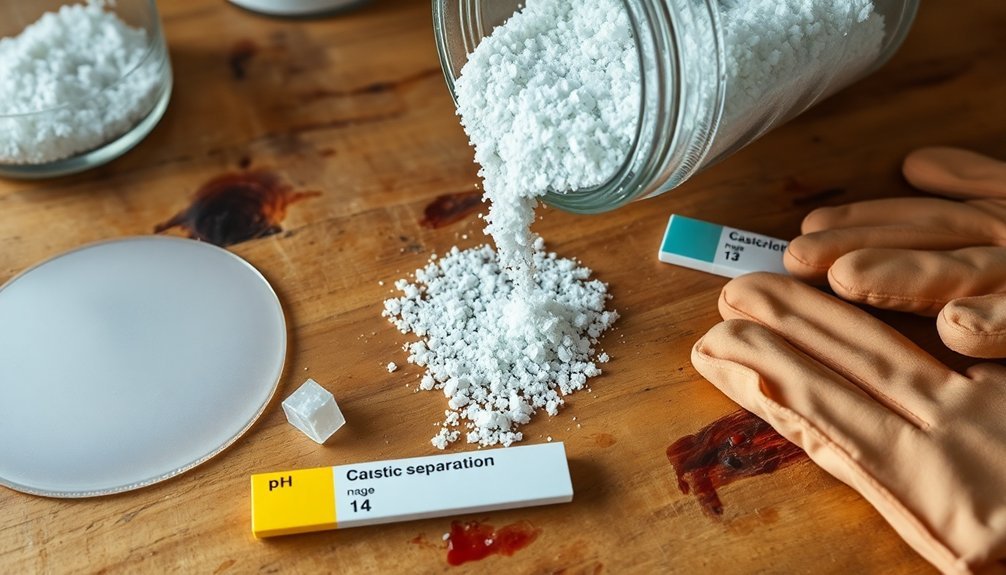
When working with lye, you're handling a substance that can cause severe chemical burns within seconds of skin contact.
You'll need essential protective gear—chemical-resistant gloves, safety goggles, and long-sleeved clothing—to create a barrier between your skin and this caustic ingredient.
Remember that even tiny splashes can lead to painful injuries, so treat lye with appropriate caution throughout your soap-making process.
Lye Handling Hazards
Although soap making can be a rewarding craft, working with lye demands extreme caution due to its highly caustic nature.
Sodium hydroxide can cause severe chemical burns upon skin contact, requiring proper personal protective equipment like gloves and goggles during handling.
When preparing lye solutions, you're at increased risk of splashes that can lead to immediate pain and irritation. If exposure occurs, rinse the affected area with water for at least 15-20 minutes to minimize damage.
Remember that accidental inhalation can cause respiratory distress, while ingestion results in internal burns.
Always work in well-ventilated areas and store lye securely, properly labeled and out of children's reach.
Misidentification or improper handling during soap making can lead to dangerous accidents. Your safety depends on treating lye with the respect this powerful chemical deserves.
Protective Gear Essentials
Because handling lye poses serious health risks, you'll need to equip yourself with essential protective gear before starting any cold process soap making.
Always wear safety goggles to shield your eyes from potential lye splashes that can cause severe chemical burns or permanent damage.
Choose nitrile gloves over latex, especially if you have allergies, guaranteeing they fit properly to prevent lye solution from seeping in and causing skin exposure. Loose gloves compromise protection when handling raw soap.
Keep running water or an eyewash station nearby for immediate rinsing if accidents occur.
Regularly inspect your safety gear for signs of wear or damage that could reduce their effectiveness.
This simple maintenance routine helps guarantee your protective equipment remains reliable when working with caustic materials.
Proper Ventilation to Prevent Respiratory Damage
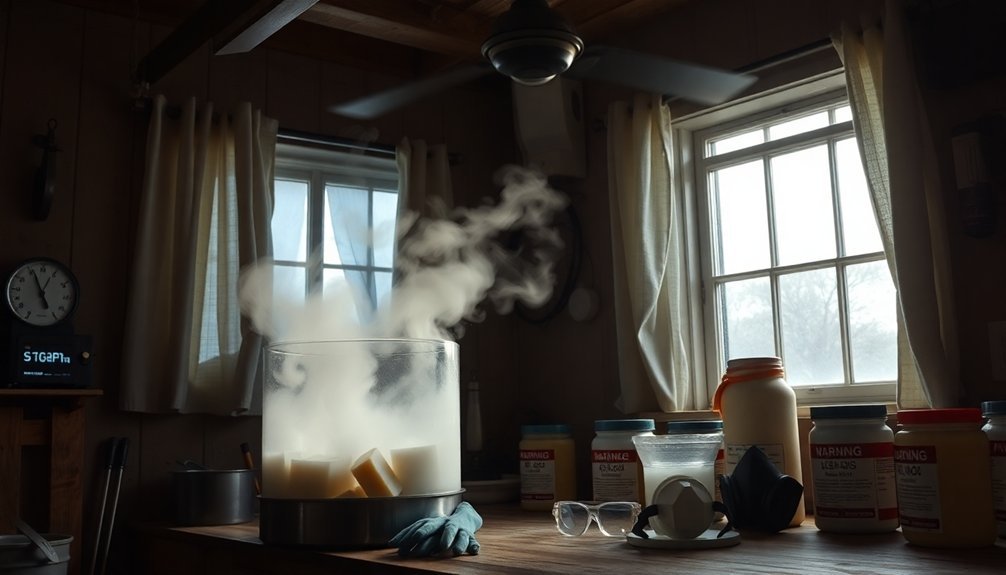
Why is ventilation often overlooked in soap making tutorials? Many creators focus on the exciting aspects of color and fragrance while downplaying vital safety measures that protect your respiratory system.
Proper ventilation is essential during lye mixing, as this chemical reaction releases harmful fumes that can cause immediate irritation and long-term damage. Always work outdoors or in well-ventilated areas when handling lye.
Install exhaust hoods or fans to disperse fumes and improve air quality in your workspace. An air purifier provides additional protection by filtering particulates and volatile compounds.
Without adequate ventilation, you're risking respiratory sensitization and potential allergic reactions from repeated exposure to lye and fragrance oils. This often-neglected safety measure could be the difference between a healthy hobby and serious health complications.
Essential Protective Equipment for Soap Makers
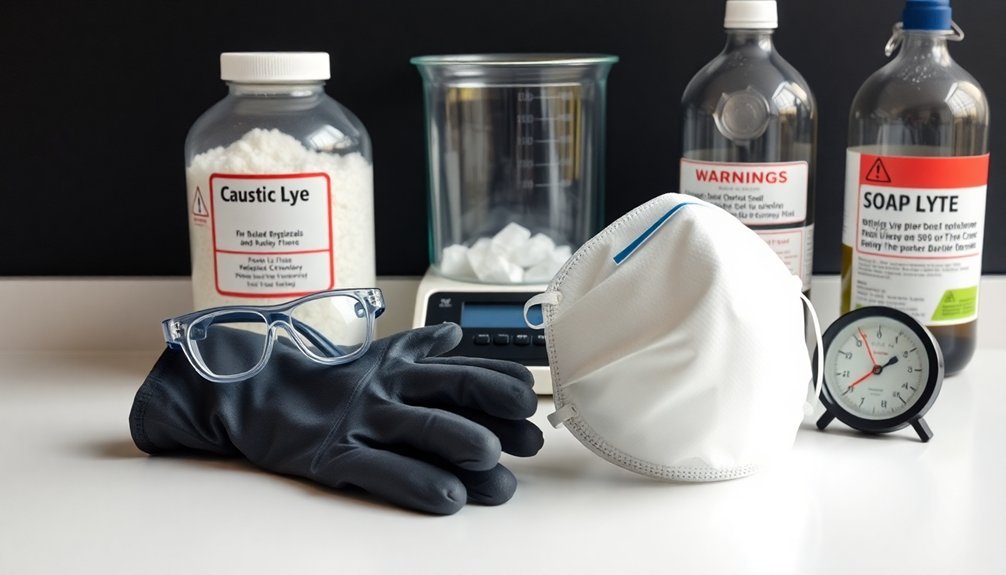
Beyond setting up a well-ventilated workspace, you'll need proper safety gear to shield your body from potential harm. When handling lye solution and raw soap, the right protective equipment stands between you and serious chemical burns.
- Safety goggles are non-negotiable – they protect your eyes from splashes that could cause severe irritation or burns.
- Nitrile gloves provide essential hand protection and are suitable for those with latex allergies.
- Respirator with replaceable cartridges filters harmful fumes during mixing, greatly improving air quality.
- Clothing barriers like long sleeves and durable pants minimize skin exposure to caustic materials.
Always keep a first aid kit within arm's reach during soap making sessions. Quick access to medical supplies can make a critical difference if accidents occur despite your precautions.
Safe Handling and Storage of Sodium Hydroxide
While soap making brings creative joy to crafters, sodium hydroxide demands your utmost respect and caution. This caustic substance can cause severe chemical burns if mishandled, so proper handling safety is non-negotiable.
Always store sodium hydroxide lye in a securely sealed container, clearly labeled and out of reach of children and pets.
When working with lye, wear complete personal protective equipment—gloves, goggles, and masks—to shield yourself from harmful splashes and fumes.
Remember the cardinal rule: add lye to water, never water to lye, to prevent violent reactions and dangerous splattering.
If lye solution spills occur, immediately flush the area with plenty of water. For any skin contact, rinse thoroughly and seek medical attention promptly.
Temperature Control and Thermal Reaction Hazards
When mixing lye with oils during cold process soap making, you'll need to monitor temperatures carefully to prevent dangerous overheating incidents that can cause severe burns and chemical splashes.
Your soap mixture can reach flash points exceeding 200°F during saponification, creating a significant risk if proper heat management techniques aren't employed.
Always use heat-resistant equipment and work in a well-ventilated area to minimize the thermal reaction hazards that occur when exothermic processes intensify unexpectedly.
Lye Overheating Incidents
The chemical reaction between lye and water creates substantial heat that demands your careful attention during soap making.
When you're handling lye, overheating becomes a significant safety concern that can transform your crafting session into a hazardous situation. Temperature control is essential to prevent dangerous thermal reactions.
- Volcanic eruptions – Excessive heat accelerates saponification, causing soap mixtures to overflow containers like molten lava.
- Container failures – Improper vessels may melt or crack when exposed to lye's intense heat, creating dangerous spills.
- Unpredictable reactions – When temperatures exceed 200°F, lye becomes unstable, compromising both safety and soap quality.
- Severe burns – Overheated lye solutions can cause immediate and serious skin damage on contact.
Flash Point Dangers
Understanding flash point temperatures represents a critical safety element in cold process soap making that many beginners overlook.
When you're combining lye solution with oils at high temperatures, you're creating conditions for potential thermal reaction hazards that require careful monitoring.
Fragrance oils often have lower flash points than the temperatures your soap mixture reaches during processing. If you add these oils when your mixture is too hot, you risk combustion and dangerous fumes.
Temperature control isn't just about preventing overflow—it's about avoiding a volatile mixture that can cause chemical burns if it spills.
Always verify the flash point of every ingredient you're using and maintain strict temperature monitoring throughout the process.
This vigilance helps prevent dangerous reactions when your lye solution interacts with oils, ensuring your creative process doesn't become hazardous.
Child and Pet Safety Considerations
Anyone working with cold process soap must prioritize keeping children and pets safe from the dangerous chemicals involved. Lye can cause severe chemical burns upon contact, potentially leading to serious injuries or health complications.
To guarantee safety during your soap-making process:
- Never allow children to handle lye or be present during the mixing process.
- Keep pets in separate areas to prevent accidental ingestion of hazardous materials.
- Store all supplies in childproof containers with clear warning labels.
- Educate your family about the dangers associated with lye and soap-making.
Prevention is essential—even small amounts of lye can be harmful.
Potential Allergic Reactions to Ingredients
While creating beautiful handmade soaps brings joy to many crafters, certain ingredients in cold process soap can trigger allergic reactions ranging from mild skin irritation to severe respiratory distress.
Essential oils and fragrance oils are common culprits, accounting for a significant percentage of adverse reactions in cosmetic products.
The high pH nature of cold process soap can worsen these reactions, especially if you have pre-existing conditions like eczema or psoriasis.
Plant extracts, colorants, and preservatives may also contain potential allergens that affect sensitive individuals.
To protect yourself and your customers, always conduct patch tests before using new formulations.
Proper labeling of all ingredients is essential—it's not just good practice, it's your responsibility to inform users about possible allergens in your handcrafted soaps.
Emergency Protocols for Chemical Exposure
Because cold process soap making involves handling caustic chemicals like sodium hydroxide (lye), you must establish clear emergency protocols before beginning any project.
These safety procedures can mean the difference between minor irritation and serious injury.
- Skin exposure: Immediately rinse affected area with plenty of water for at least 15 minutes. Seek medical attention if irritation persists.
- Eye contact: Flush eyes with running water for 15+ minutes while holding eyelids open. Seek emergency medical care immediately.
- Ingestion: Don't induce vomiting. Rinse mouth thoroughly and contact Poison Control at 1-800-222-1222.
- Preparation: Keep a first aid kit nearby with gauze, antiseptic wipes, and burn ointment.
Regularly practice these emergency protocols with anyone participating in your soap making process.
Frequently Asked Questions
Is Making Your Own Soap Dangerous?
Yes, making your own soap can be dangerous. You're handling caustic lye that burns skin and creates harmful fumes. You'll need proper safety equipment, ventilation, and knowledge of emergency procedures to minimize risks.
Why Did My Cold Process Soap Explode?
Your soap likely exploded due to excessive heat from high temperature mixing, overpacked molds, gas-releasing ingredients, improper mixing that created lye pockets, or incompatible additives that disrupted the chemical balance.
Should You Wear a Respirator When Making Soap?
Yes, you should wear a respirator when making soap. It protects you from harmful lye fumes, essential oils, and colorants that can irritate your respiratory system and potentially cause long-term health issues with repeated exposure.
Why Is Soap Hazardous?
Soap itself isn't hazardous, but making it can be. You're working with caustic lye that burns skin and creates dangerous fumes. Without proper protection, you're risking chemical burns and respiratory issues.
In Summary
You've learned that cold process soap making involves genuine hazards, but they're manageable with proper precautions. Always respect lye's caustic nature, wear your protective gear, guarantee good ventilation, and keep your workspace off-limits to children and pets. Don't skip safety steps even as you gain experience. With these practices in place, you'll enjoy your creative soap making journey while keeping yourself and others safe.

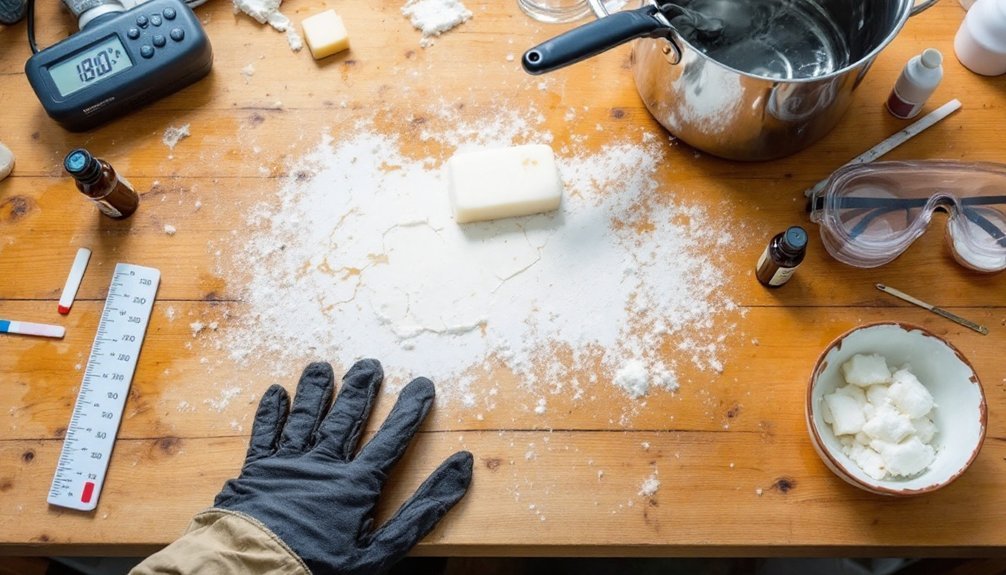



Leave a Reply